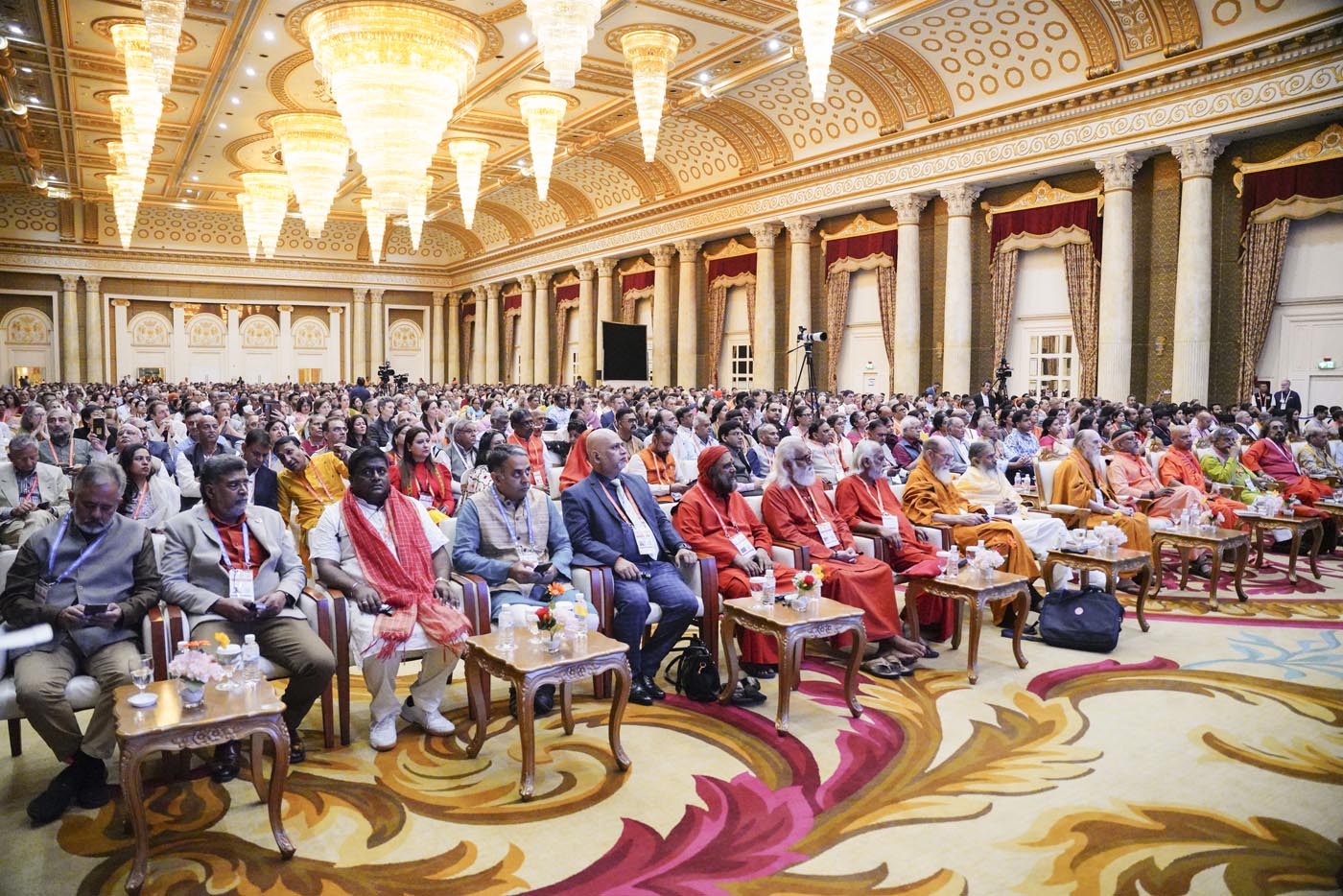This three-day meeting of over two thousand delegates from 61 countries in Thailand reflected a remarkable awakening of Hindus worldwide
The world hindu congress, held from November 24 to 26, 2023 in Thailand, was a clear sign of an unfolding Hindu renaissance. Speaker after speaker detailed how Hindus spiritually, economically and politically are regaining their traditional place in the world order. This is the third congress organized by the international World Hindu Foundation. The first was held in Delhi in 2014, the second in Chicago in 2018 and now the Covid-delayed third in Bangkok’s enormous Impact Centre convention facility.
With 2,100 participants from 61 countries, the event was opened by Swami Vigyanananda, the joint general secretary of the Vishva Hindu Parishad, Bharat, and founder of the World Hindu Foundation. Its aim, he said, “is to make the Hindu identity visible, respectable and acceptable worldwide, to make the words Hindu and Hindu Dharma popular and fashionable in modern society.”
Dr. Mohanrao Bhagwat, Sarsanghchalak (president) of the Rashtriya Swayamsevak Sangh, one of the main organizers of the event, spoke on the Congress’ slogan, Jayasya Aayatnam Dharma, “Dharma—The Abode of Victory.” He distinguished between three kinds of victory: that of the asuras or demons, in which there is only destruction; that of kings, where the only goal is to increase material benefits through fighting and dominating others; and that which stands on dharma—a “process that is carried out by Dharma’s rules and its result is also Dharma. The world is looking at us with hope,” he said, “and we have to fulfil our role. India can show the path of happiness and satisfaction, and this is being accepted by global leaders.”
Hinduism Today itself was honored in the first plenary session, along with the Bharat Sevashram Sangha and the Mata Amritanandamayi Math. In presenting the plaque of recognition to Satguru Bodhinatha Veylanswami, this magazine’s publisher, Shri Milind Shrikant Parande, secretary general of the Vishwa Hindu Parishad, said the publication “is regarded as the single most [effective] advocate of Hindu Dharma outside of Bharat.” (See text of the award at right.)
Swami Purnatmananda, acting president of the Bharat Sevashram Sangha, said after receiving their award, “Hindus will have to unite to protect dharma. For the victory of Sanatan Dharma, we all have to work together for society.” Mata Amritanandamayi, popularly known as Ammachi or the Hugging Saint, accepted the award on behalf of the Math. She said, “A very powerful vibration pervades every particle of sand, every atom and the very atmosphere of our country, Bharat. It is the vibrations of Vedic chants and spiritual austerity performed by countless ancient rishis, it is the pulsation of spiritual power. This is the invaluable specialty of Sanatan Dharma…. We Hindus are the children of Supreme Consciousness and Supreme Knowledge. Bharat is the land that taught the world the ultimate truth. May the entire world become one family.”
The Prime Minister of Thailand, Srettha Thavisin, sent a message welcoming the Congress to the country. It said, in part, “The world struggling with turmoil should take inspiration from Hindu values of nonviolence, truth, tolerance and harmony. Only then would peace be established in the world. The Vedas visualize the key principles of synthesis and balance for a peaceful coexistence. The concept of shanti [peace] is established on these principles.”
Two evening plenary events were held, the first titled, “Strengthening Hindu Organizations for Hindu Resurgence” and the second “Accelerating Bharat’s World Standing, The Power of Education, Economy and Technology.” In general the presentations focused on the need for Hindu unity to successfully counter the historically negative treatment of Hindus and Hinduism that unfortunately seems on the increase lately.
At one of these sessions, a resolution was adopted to advocate that the terms Hindutva and Hindu Dharma be used instead of Hinduism, on the basis that “ism” always carries a negative connotation. However, it is not correct that “ism” always carries a negative connotation. Many terms ending in “ism,” like Buddhism, Judaism and activism, are used neutrally or positively. Prior to the entire Congress, all speakers had been asked to use Hindu Dharma instead of Hinduism or Hindu religion and Bharat instead of India. With this resolution, Hindutva was proposed as the preferred term, even though it is largely associated with the RSS as an organization and not as a general appellation for the religion. No consensus was arrived at on the proposal. The recommended use of Bharat, being one of the country’s official names (along with India) in its constitution, was well received. [See sidebar page 33 for more discussion on the terms Hinduism, Hindu religion, Hindu Dharma and Hindutva.]
Seven Conferences in One Event


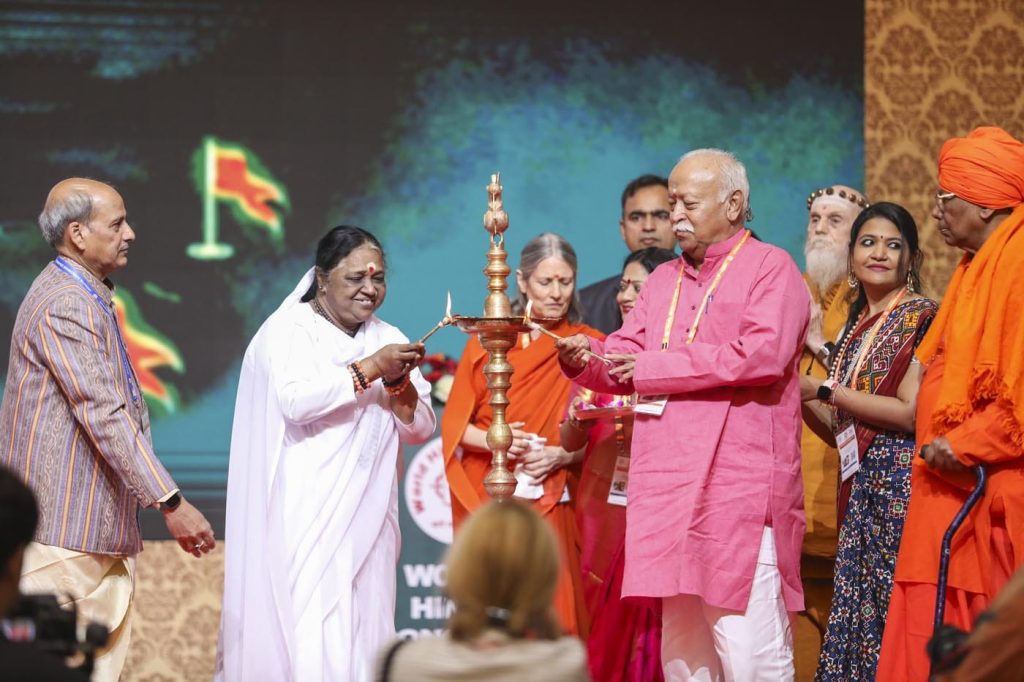

To say the Congress was a complex event would be an understatement. There were 200-plus speakers among the seven conferences, each of which split into five or more sessions. It was impossible to be personally present for more than a small section of the event.
The speakers were an extremely diverse group—academicians, swamis, religious leaders, business people, scientists, diplomats, medical professionals, investors, artists, writers, dancers, educationalists, reporters and film makers. While most were from India, a large contingent came from Thailand itself and smaller ones from the US, UK, New Zealand and Australia. One or more speakers came from Mauritius, Norway, Germany, Suriname, Kenya, Sri Lanka, Qatar, Zambia, Indonesia, Switzerland, Russia, Netherlands and Pakistan.
Fortunately, the closing plenary session included a summary by the leaders of each of the individual conferences, starting with the World Hindu Economic Forum. Dr. Manoj Motwani, its chair, is a successful businessman based out of Hong Kong. He described a wide variety of ways the economic interest of Hindus could be advanced, ranging from adopting the latest in agricultural techniques to manufacturing partnerships with ASEAN countries, investments in health, and encouraging startups in Bharat. The last session took this one step further by actually evaluating submitted business startup proposals and seeking to pair them with potential investors on the spot.
Prof. Nachiketa Tiwari of IIT Kanpur, who has instituted over 25 postgraduate-degree programs in Hindu studies in Bharat universities, chaired the Hindu Education Board. Their topics included the politics and ideology surrounding Hindu art forms today; how to improve Bharat’s education system—in particular to better fit with the world’s changing economic needs; strengthening the understanding of Hindu knowledge systems in the modern academic world; and the problems of Western academic theories dominating the narratives of Bharat’s history, specifically the impact of Marxist principles in historical analysis.
Their final topic was the consistently negative portrayal of Hindu dharma and traditional societal structure in the media and academia. The speakers on this topic pointed out that not only is Hindu culture portrayed this way, but all traditional societies—Japanese Shinto, Korean, Sri Lankan, etc. Professor Nitin Tripathi of the Asian Institute of Technology recommended Hindus seek alliances with people of other traditional societies to counter this entrenched pattern of anti-Hindu teaching.


The media conference was chaired by Vikram Sharma, editor of HinduPost.in and head of the Hindu Media Forum, which was formed in 2013 to advocate for Hindus and Hindu Dharma. Sharma said the forum seeks to “ensure that the correct perspective on issues impacting Hindus is provided.” Overall, the sessions addressed what is called the “narrative,” which in this context is a somewhat technical term with this dictionary definition: “a representation of a particular situation or process in such a way as to reflect or conform to an over-arching set of aims or values.” For most of India’s media, that over-arching set of aims or values consists of left-over attitudes and interpretations from the British era, in which Hindu Dharma is not treated with historical accuracy.
By far the most popular speaker at this conference was Vivek Ranjan Agnihotri, producer of The Kashmir Files, a bold, dramatic film portraying the forced exodus of the Kashmir Pandits from the Kashmir Valley in 1990. The commercially successful and highly controversial movie was an attempt to correct the all-to-common narrative pushed by parts of the Indian and world media that the Pandits left voluntarily, or at least not fearing some sort of “genocide,” when the reality of the situation—a systematic reign of terror aimed at driving them out—was much different.
Hinduism Today was invited to speak at this conference as an example of a publication which was making progress in revising the narrative of Hindu Dharma within the English-speaking world. Our managing editor, Acharya Arumuganathaswami, described the wide network of sources, talented reporters and decades of experience which goes into the magazine’s production.
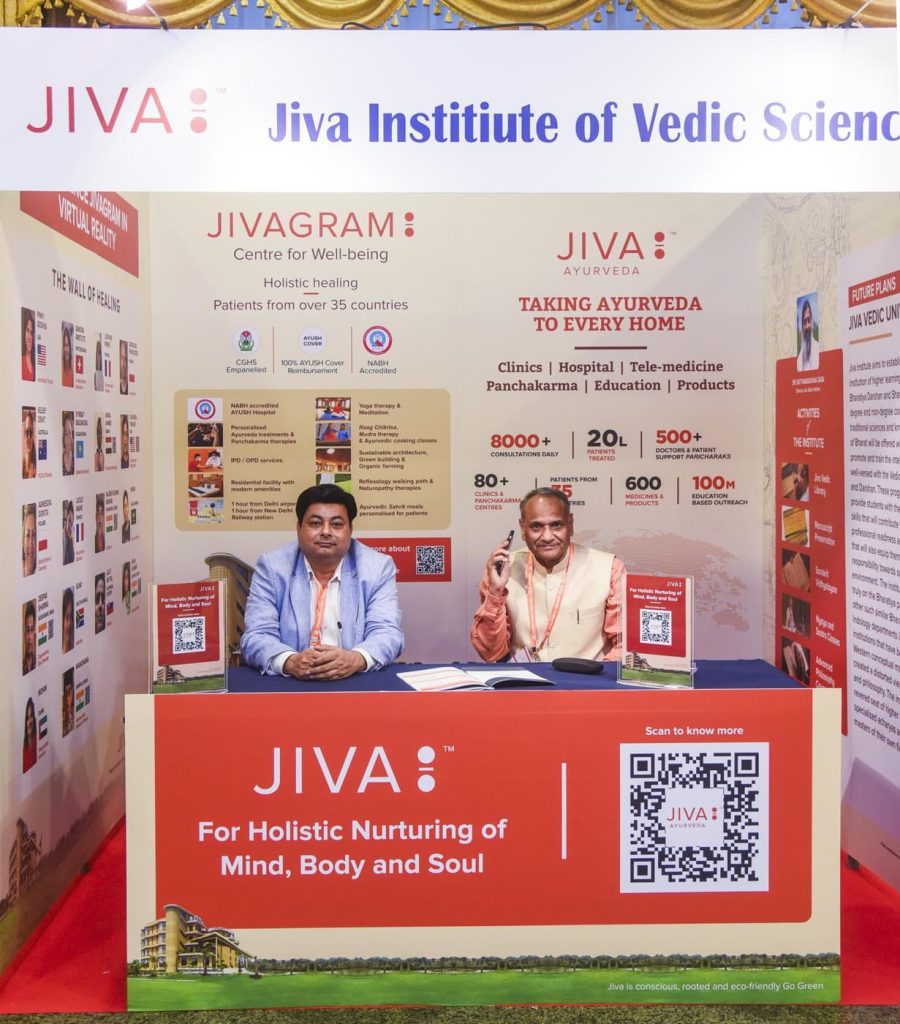



He also addressed the “ownership of the narrative of the history of Bharat,” pointing out that nearly all historical analysis in today’s academic world is based on the approach of three recent philosophers: Friedrich Nietzsche, who famously said, “God is dead;” Karl Marx, who called religion “the opium of the people” and regarded all of history as that of class struggle; and Sigmund Freud, who judged religion a form of insanity. It is from this set of foregone conclusions—that we live in a Godless world where righteousness is rare and the main motivation behind any happening is selfish gain—that the narratives of not only the history of Bharat but of all indigenous peoples has been shaped. The same analysis and observations—especially on Marxist historical interpretations—came up in one session of the Hindu Education Conference. Many other issues brought up at the Congress trace back to this false narrative in which dharma does not exist.
The World Hindu Democratic Forum conference focused on Hindu involvement in politics on a global scale and included Hindu politicians from multiple countries. Rashmi Samant, first Hindu president-elect at the University of Oxford Students Union, said the Forum was founded to create an ecosystem of support for Hindu candidates to ensure “that generation after generation there are Hindu politicians in positions of power” in the countries with a significant Hindu population.
Next was the Hindu Women Conference, chaired by Pritika Sharma, the former joint general secretary of the Hindu Council of New Zealand and professionally active in child and family services. She spoke in terms of the global Hindu renaissance, a phenomenon touched upon by many other speakers. One purpose of the conference, she said, “is to put a woman’s perspective and view forward because that is 50 percent of Hindu society,” and to “develop leadership qualities within Hindu women so they can assume leadership positions in the Hindu resurgence and renaissance.” Speakers dealt with the problem that the current academic system raises “apologetic Hindus,” and how to change that.
Some focused on the different social, cultural and legal rights of women in Hinduism, Christianity and Islam, and how these should be made more clear. A strong point was made that women are disproportionately impacted by human rights violations, such as land grabbing, love jihad and other forms of oppression.
Murali Krishna Magesan, coordinator of the Hindu Students and Youth Network and president of Hindu Youth New Zealand, presided over the Hindu Youth Conference, whose theme was “rise, organize, lead, emerge.” The Youth Network aims to “serve as a catalyst to initiate synchronized action and effective networking for all Hindu students and youth organizations that are currently active in their countries or states.”
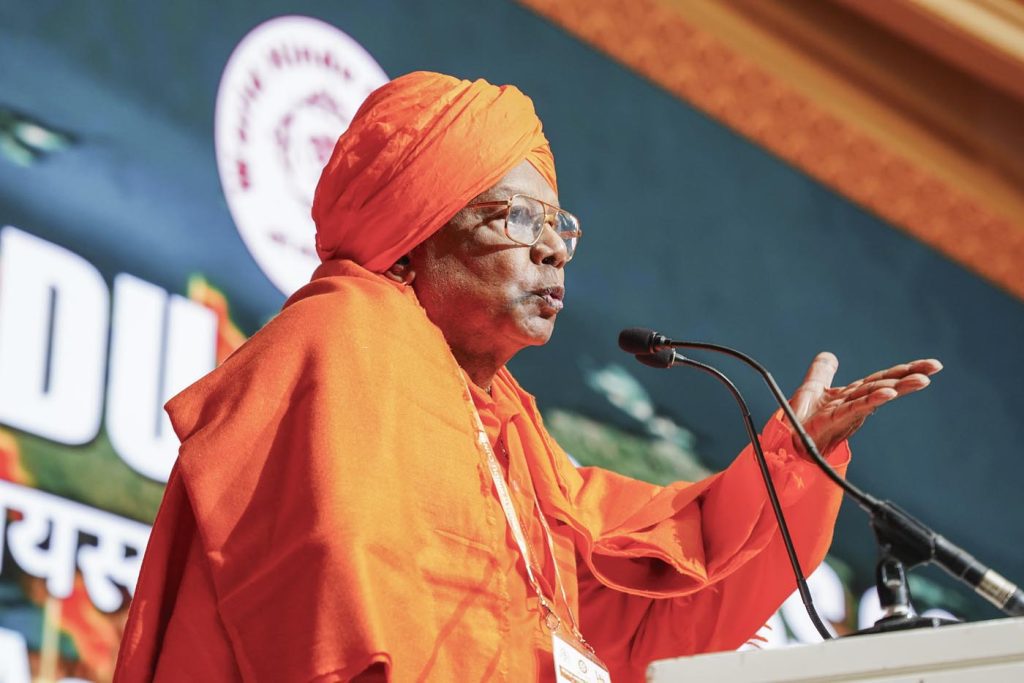



Like the Congress itself, the Youth Conference covered six topics: Hindu identity, economy, education, media, politics and human rights. Here, too, the topic of narrative was central: “We discussed the importance of reclaiming our own storytelling, and platforming and legitimizing the Hindu voice in digital media. By active participation in correcting perception, young Hindus can make important strides in reclaiming the Hindu narrative.”
The Hindu Organizations Conference was led by Prof. Guna Magesan, president of the VHP of New Zealand. Their first session dealt with the government control of Hindu temples and related issues. “The main thing that came out,” Magesan reported, “was that all Hindu temples destroyed by invaders be reclaimed”—specifically naming the Kashi and Mathura temples. One of their prominent speakers was A.G. Ponn Manickavel, a retired inspector general of police, who has retrieved hundreds of stolen murtis of Deities. Vishnu Shankar Jain and Rangarajan Narasimhan both addressed efforts to free temples of government control, particularly in Tamil Nadu.
Other sessions dealt with protecting Hindu youth from love jihad and strengthening family values through better education in dharma. Several dealt in one way or another with Hindu Dharma outside of Bharat—in Asia, Africa and South America. There was much talk about Hindu human rights in countries such as Pakistan. The final session brought together heads of six Thailand-based Hindu organizations of various Bharatian languages.
Participants’ Feedback
These short summaries do little justice to the rich content of each session and the remarkable qualifications and accomplishments of the 200 speakers who participated. Those attending came away with a distinct appreciation for the advancements Hindus have made on all fronts in recent decades.
Ravi Chand, producer, director and writer of Warrior Tribe Films in Australia, was a fellow speaker with Hinduism Today at the Hindu Media Forum. He wrote, “It was wonderful to connect with the Hindu community from around the world in such a supportive manner. I was so pleasantly surprised by the outpouring of emotion and support for our TV and film projects, and I continue to talk with our Hindu community from around the world.”
Kavita Krishna Meegama of brhat.in, which promulgates Indian Knowledge Systems on their blog, was equally pleased: “For all us what was most satisfying was meeting with Hindus from other countries, other continents—those whom we do not get to meet otherwise or hear from. This combination of Hindu grassroots workers, academics, economists, politicians, spiritual leaders, activists, experts in various fields and civil society members from all over the world congregating in such large numbers bodes well for our future.”
Govinda Subedi of the the Global Bhutanese Hindu Organization was overall very pleased with the event. It provided excellent exposure to the concerns of the Hindus who were forced out of Bhutan starting in the 1990s, first to refugee camps in Nepal, then eventually settling in Europe, Australia and North America. He did feel the Congress focused overmuch on the concerns of Indian Hindus, “potentially marginalizing the experiences of non-Indian Hindu communities.”


Concluding Thoughts
Mata Amritanandamayi delivered an inspiring message in her closing talk, one which captures the spirit of the event: “The Hindu faith presents a collection of principles and values that have the potential to bring well-being and prosperity to all. It was the Hindu faith that offered the concepts of dharma and yajna—virtue and self sacrifice—to the world.” She emphasized the fact that Sanatana Dharma is the only religion that has accepted the fact that there are diverse paths to the truth. “In these modern days, people seeking peace of mind have made cell phones and intoxicants their peacemakers. They have no interest in seeking or knowing the ultimate peacemaker, God. As a result, we are witnessing the progressive destruction of our world. We are not candles dependent on others to be lit. We are the self-effulgent Sun. We are not helpless kittens; we are all powerful lions. We have infinite potential within us.”
Those in attendance were well pleased with the entire event, from the quality of the speakers to the excellent meals offering both Indian and Thai vegetarian dishes. The 36-acre Impact Centre is the second largest convention facility in Asia. While the Congress made use of multiple large and small meeting rooms and halls, it was just a minute portion of the immense facility. The fourth World Hindu Congress is scheduled for Mumbai, December 18 to 20, 2026, with the theme “Shared commitment, collective resolve.” Next year, 2025, will mark the 100th anniversary of the founding of the RSS.
Satguru Bodhinatha Veylanswami observed that Hinduism Today’s founder, Satguru Sivaya Subramuniyaswami, spoke of a coming Hindu renaissance as far back as the 1980s. Bodhinatha described this conference as the predicted renaissance coming into its fullness.
An Award for Hinduism Today
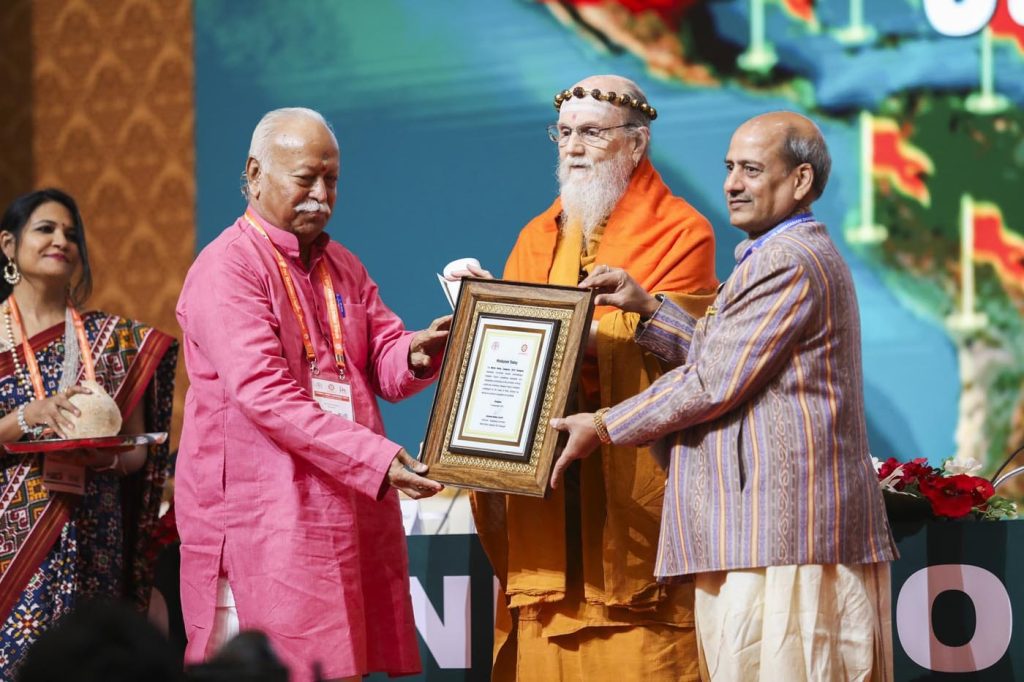

“The Organizing Committee of the World Hindu Congress, 2023 Bangkok, wishes to express profound appreciation for the remarkable contributions made by Hinduism Today since its establishment under the guidance of Satguru Sivaya Subramuniyaswami, a devoted disciple of Jnanaguru Yoga Swami from Jaffna, Sri Lanka. Hinduism Today’s commitment to nurturing Hindu solidarity, fostering unity and dispelling misconceptions about Hindu Dharma is truly praiseworthy. It has served as a guiding light of knowledge, inspiration and awakening for Hindus across the globe. The unwavering dedication to nurturing the ongoing spiritual Hindu renaissance and providing a valuable resource for Indian leaders and educators is immeasurable. Hinduism Today’s pivotal role in preserving and promoting the rich heritage of Hindu Dharma is deeply appreciated. We extend our heartfelt gratitude for your tireless efforts in upholding the essence of Hindu Dharma and sharing its wisdom with the world.”
What to Call Ourselves?
Hinduism, Hindu religion, Hindu dharma, Hindutva—parsing the terms
By Prof. Arvind Sharma
The world hindu congress recommended that Hindus drop the word Hinduism to refer to our tradition, and instead use the words Hindutva or Hindu dharma. These suggestions open the door for a discussion of the proper word for describing what is now known as the Hindu religious tradition.
Several terms have been used over the past two hundred years in relation to the Hindu religious tradition, and it might be worth examining the context in which they arose to enable us to arrive at a reasonable conclusion in this respect.
The word Hinduism is widely used to describe the tradition under discussion. This use of the word, however, is not without its problems. The first of these centers on the relationship of the Hindu tradition to the non-Abrahamic religions present in India, such as Buddhism, Jainism and Sikhism. Sometimes the word Hindu is employed in a way which embraces the entire spectrum of what are now being called the “Dharmic traditions”—Hinduism, Buddhism, Jainism and Sikhism. At other times, it is used to refer to the Hindus alone, as distinguished from Buddhists, Jainas and Sikhs. This ambiguity in its use has important constitutional and legal implications, particularly in India. The second problem is more subtle. According to the standard notion of a religion, such an entity is distinguished by a set of beliefs and practices which are unique to that religion. For instance, in the case of Judaism, it would be the acceptance of the Shema; in the case of Christianity, it would be the acceptance of Jesus as the Lord and Savior; and in the case of Islam, it would be the acceptance of the Shahadah. All these religions also have a specified set of beliefs and practices, on the basis of which one can distinguish between an insider and an outsider.
Such a Western definition of a religion creates a problem in the case of Hinduism, which does not seem to share a common set of beliefs and practices. It is true that certain doctrines within it are widespread, such as belief in karma, and the same could be said of some of its practices, like the rituals by which Hindus get married or are cremated. But, although widespread, none of them is universal.
The word Hindutva was apparently first used by Chandranath Basu (1844-1910) in the late 1800s. Its present understanding, however, has been decisively shaped by its use by Vinayak Damodar Savarkar (1883-1966) in his seminal work Hindutva: Who is a Hindu?, first published in 1923.
The word can be understood at two levels. It carries a Sanskrit suffix (tva), which makes a thing what it is in the abstract. Thus, one meaning the word could convey is “the property or quality of being a Hindu.” It is, however, its second meaning with which it is now associated in the popular imagination. In this more precise, if narrower, understanding, it refers to the culture which is shared by all religions of Indian origin—Hinduism, Buddhism, Jainism and Sikhism—as contrasted with other religions present in India which are not of Indian origin, such as Christianity and Islam. The word also has an assertive ambiance associated with it, and the expressions “Hindu nationalism,” and “political Hinduism” have been used to define it. Sister Nivedita (1867-1911) once produced a manifesto of what she described as “aggressive Hinduism,” and the term conveys some of the militancy which has come to be associated with the word Hindutva.
An interesting aspect of the situation is that the word dharma is used by all the four religions of Indian origin—Hinduism, Buddhism, Jainism and Sikhism—to describe themselves. It is in such a context that the term Hindu Dharma is used to distinguish the Hindu religious tradition from the other three aforementioned traditions. Purists like to point out that the word Hindu is not a Hindu word, and therefore the best way to describe the tradition we are discussing is the term the tradition uses to describe itself, namely, Sanatana Dharma. There is epigraphic evidence to suggest the term was being used by the tradition to describe itself by the sixth century ce.
The word Sanatana can convey three levels of meaning. It can mean something eternal, immemorial, and/or universal. When the term Sanatana Dharma is understood in the first sense, then it implies a religious tradition which is based on the eternal Vedas. In this sense, it is also sometimes called Vaidika Dharma. From a historical point of view, it is also possible to describe the tradition under discussion as Sanatana in the sense that it is an immemorial tradition, whose origins are lost in the mist of antiquity. This use of this word also helps distinguish this tradition from Buddhism, Jainism and Sikhism which, in the modern academic understanding, are religions which have their origin in history. Thus, all of them can call themselves Dharma, but Hinduism, as Sanatana Dharma, then becomes a tradition from which they depart as offshoots at determinable points in history.
What, then, should we call ourselves? Let us first examine the suggestion made by the resolution of the World Hindu Congress (2023) that Hindus should discard the word Hinduism to refer to their religion, and use either Hindutva or Hindu Dharma in its place. This first alternative is difficult to support because the word Hindutva has acquired a special connotation as referring to that dimension of the Hindu religious tradition which focuses on the concept of a Hindu nation or a Hindu state. The word Hinduism carries a broader connotation, and therefore the two cannot be used as equivalents.
The case for using Hindu Dharma instead of Hinduism is a stronger one. However, while Hindu Dharma is a viable locution within the Indian subcontinent, it is not as widely used as Hinduism outside the subcontinent. Hence the use of this term to denote Hinduism, in an international context, may cause unnecessary confusion. Moreover, the Hindu religion, as a minority religion, enjoys certain rights outside India in the various countries which the Hindus inhabit in the diaspora. In these countries, Hindus are seen as a people who practice a religion called Hinduism. The use of the term Hindu Dharma, then, may jeopardize the legal protection Hindus enjoy in these countries. I think it would be wise to be governed by the context under discussion when it comes to choosing the right term.


Arvind Sharma is Birks Professor of Comparative Religion, McGill University, Montreal, Canada. His influential writings focus on Hinduism and the philosophy of religion.


